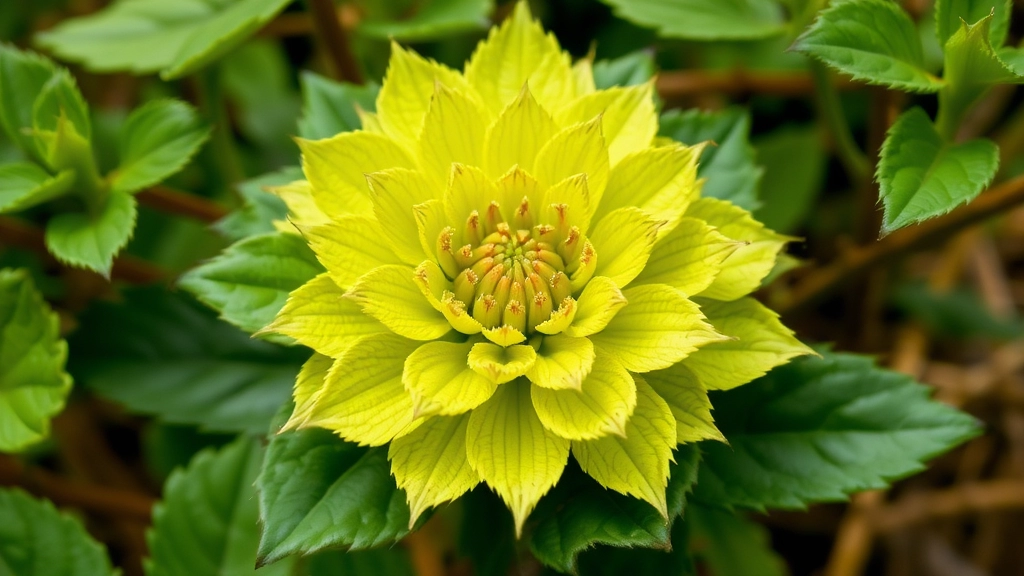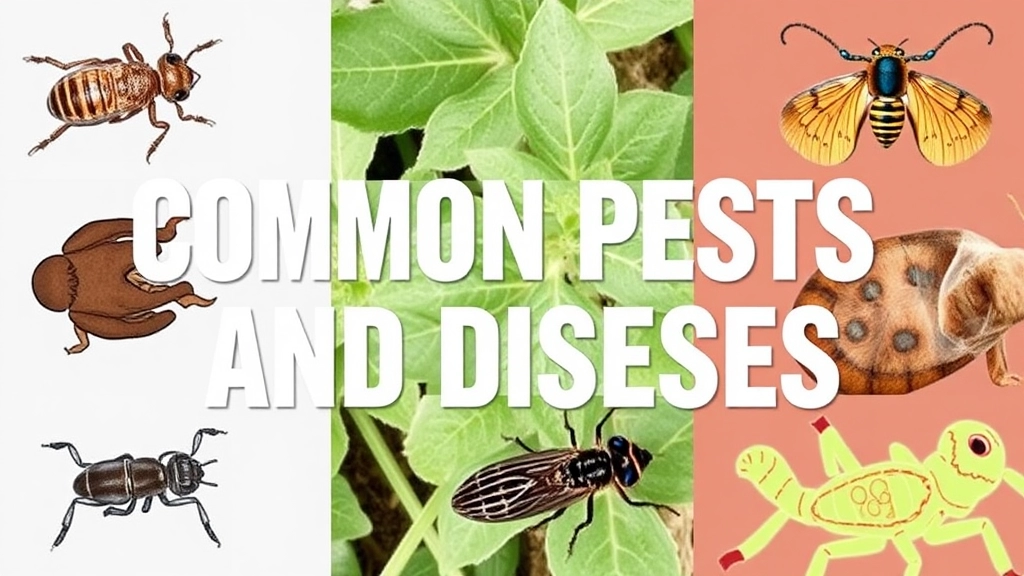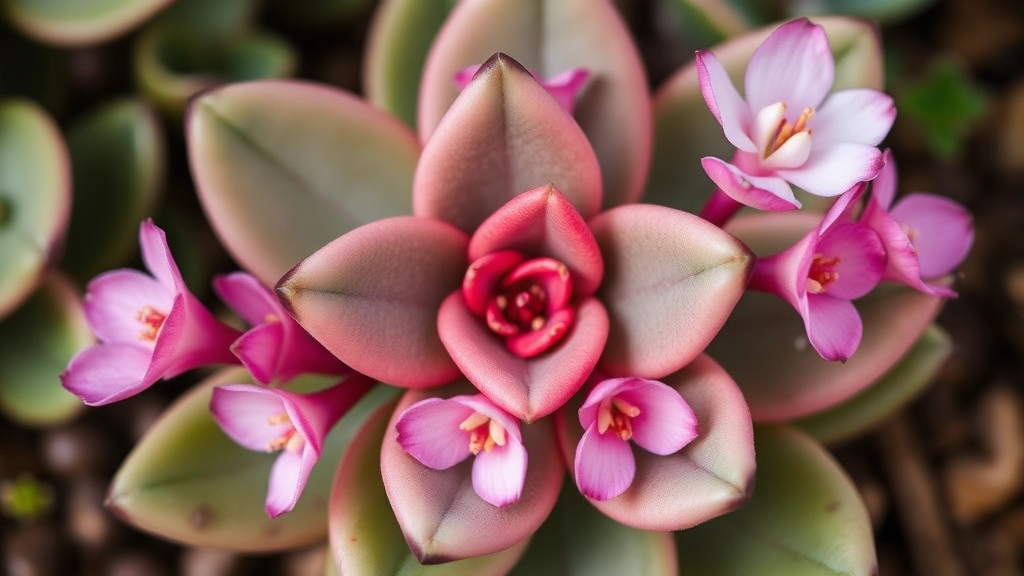Welcome to the fascinating world of Kalanchoe dineshii!
As a plant enthusiast, I’m thrilled to share my insights on this unique succulent. This compact beauty, named after Indian botanist Dr. Dinesh Parmar, is turning heads in the plant community with its distinctive features and low-maintenance nature.
Exploring Kalanchoe dineshii
In this article, we’ll explore Kalanchoe dineshii’s botanical characteristics, natural habitat, cultivation tips, and more. Whether you’re a seasoned gardener or a curious newcomer, you’ll discover why this resilient plant is becoming a favorite among succulent lovers. Let’s dive in and uncover the secrets of this little green wonder!
Overview of Kalanchoe dineshii
Let’s chat about Kalanchoe dineshii, a plant that’s been turning heads lately.
Ever stumbled upon this little green wonder and thought, “What’s the deal?”
Well, you’re not alone.
Kalanchoe dineshii is a succulent that’s got plant lovers buzzing.
It’s part of the Crassulaceae family, which is fancy talk for “plants that store water like champs.”
This particular Kalanchoe was named after an Indian botanist, Dr. Dinesh Parmar.
Cool, right?
But here’s the kicker – it’s not your average houseplant.
Kalanchoe dineshii is a bit of a rebel in the plant world.
It’s got these unique leaves that look like they’ve been sculpted by nature’s finest artist.
And the flowers? They’re like tiny fireworks on a stem.
But don’t let its good looks fool you.
This plant’s tough as nails.
It can handle drought like a pro and doesn’t need much fuss to thrive.
So, whether you’re a green thumb or a plant newbie, Kalanchoe dineshii might just be your new best friend.
Ready to dive deeper into the world of Kalanchoe dineshii?
Let’s go!
Botanical Characteristics

Let’s dive into the nitty-gritty of Kalanchoe dineshii, shall we? This little beauty’s got some unique features that’ll make you go, “Huh, that’s pretty cool.”
Appearance and Growth Habit
First off, picture this: a compact succulent that’s not trying to take over your entire windowsill. Kalanchoe dineshii keeps things modest, usually growing to about 15-20 cm tall. It’s like that friend who’s always there but never overstays their welcome.
Leaves
Now, the leaves are where things get interesting:
- Shape: Oval to oblong
- Texture: Fleshy and thick (they’re storing water like it’s going out of style)
- Colour: Typically green, but here’s the kicker – they often have reddish-brown edges
- Arrangement: Opposite pairs along the stem (they’re all about that symmetry)
Flowers
When it comes to blooming, Kalanchoe dineshii doesn’t mess around:
- Colour: Usually bright yellow or orange (like a mini sun in your living room)
- Shape: Small and tubular
- Arrangement: Clusters at the end of stalks (imagine a tiny bouquet)
Stem
The stem’s not just there for show:
- Texture: Succulent and sturdy
- Branching: Can get a bit bushy as it matures
Root System
Underground, it’s all business:
- Type: Fibrous
- Depth: Shallow (it’s not trying to dig to China)
Unique Features
Here’s where Kalanchoe dineshii really stands out:
- Leaf margins: Often have tiny plantlets growing along the edges (it’s like nature’s own propagation station)
- Drought tolerance: This plant laughs in the face of forgetful waterers
- Compact size: Perfect for small spaces or as part of a succulent arrangement
So, there you have it – Kalanchoe dineshii in all its botanical glory. It’s a tough little plant with some seriously cool features. Whether you’re a succulent newbie or a seasoned pro, this one’s worth checking out. Just remember, its botanical characteristics are what make Kalanchoe dineshii stand out in the crowded world of succulents.
Habitat and Distribution
Ever wondered where Kalanchoe dineshii calls home?
Let’s dive into its natural stomping grounds.
This succulent’s a bit of a homebody, sticking mainly to parts of India.
You’ll find it chilling in the Western Ghats, a mountain range running along India’s west coast.
It’s not your average city slicker – K. dineshii prefers rocky outcrops and cliff faces.
Why? These spots offer the perfect mix of sun and shade it craves.
The plant’s adapted to survive in areas with seasonal rainfall.
It’s tough as nails, thriving in spots where other plants might struggle.
But here’s the kicker – it’s not widespread.
K. dineshii is actually pretty rare in the wild.
Conservation efforts? They’re crucial to keep this little guy around.
Climate change and habitat loss are real threats.
So, next time you’re trekking through the Western Ghats, keep an eye out.
You might just spot this resilient succulent in its natural habitat.
Remember, Kalanchoe dineshii’s home is limited, making it all the more special.
Cultivation and Care
Alright, let’s dive into how to grow and look after Kalanchoe dineshii. Trust me, it’s not rocket science, but there are a few tricks up my sleeve that’ll make your life a whole lot easier.
Growing Kalanchoe dineshii: The Basics
First things first, these succulents are tough cookies. They’re not fussy, but they do have a few non-negotiables:
- Sunlight: They’re sun-worshippers, so give ’em plenty of bright, indirect light.
- Soil: Well-draining soil is a must. Think cactus mix with a bit of perlite thrown in.
- Water: Less is more. These guys hate wet feet.
Now, let’s break it down further:
Light Requirements
Kalanchoe dineshii loves basking in the sun, but direct afternoon rays can be a bit much. I’ve found that a spot with morning sun and afternoon shade works wonders. If you’re growing them indoors, a south-facing window is your best bet.
Soil and Potting
Here’s the deal: Kalanchoe dineshii needs soil that drains faster than a leaky bucket. I mix regular potting soil with sand and perlite in a 2:1:1 ratio. Works like a charm every time.
Pro tip: Use a pot with drainage holes. Trust me, it’s a game-changer.
Watering Wisdom
Here’s where most people mess up. Overwatering is the kiss of death for Kalanchoe dineshii. I follow a simple rule: water deeply, but only when the soil is bone dry. In summer, this might mean once a week. In winter, you’re looking at once every 2-3 weeks.
Temperature and Humidity
Good news: Kalanchoe dineshii isn’t too picky about temperature. It’s happy anywhere between 15-25°C (59-77°F). As for humidity, average room humidity is fine. No need to mist or fuss about it.
Fertilising
These plants aren’t big eaters. I give mine a diluted, balanced fertiliser once a month during the growing season (spring and summer). In autumn and winter, I let them rest.
Pruning and Maintenance
Kalanchoe dineshii doesn’t need much pruning, but if you want to keep it compact, feel free to pinch off the growing tips. It’s also a good idea to remove any dead or yellowing leaves to keep the plant looking fresh.
Common Cultivation Challenges
- Leggy growth: This usually means not enough light. Move it to a brighter spot.
- Leaf drop: Often a sign of overwatering. Ease up on the H2O.
- Pale leaves: Could be too much sun. Try moving it to a slightly shadier spot.
Remember, growing Kalanchoe dineshii is more about what you don’t do than what you do. Don’t overwater, don’t overfeed, and don’t fuss too much. Give it bright light, well-draining soil, and a bit of neglect, and you’ll have a happy, healthy plant in no time.
So there you have it – everything you need to know about cultivating and caring for Kalanchoe dineshii. It’s a resilient little plant that’ll reward your minimal efforts with its unique beauty. If you’re interested in other Kalanchoe varieties, you might want to check out the Kalanchoe blossfeldiana, which is known for its vibrant flowers. For those who prefer a more unusual look, the hairy Kalanchoe tomentosa is an intriguing option. Happy growing!
Propagation Methods
Let’s talk about how to make more of these cool Kalanchoe dineshii plants.
Leaf Cuttings: The Easy Way
Ever tried growing a plant from just a leaf? It’s pretty wild.
Here’s how:
- Pluck a healthy leaf
- Let it dry for a day or two
- Pop it on some well-draining soil
- Wait for roots and tiny plants to sprout
It’s like magic, but it’s just plant science.
Stem Cuttings: For the Impatient Gardener
Want faster results? Go for stem cuttings.
Quick steps:
- Cut a 4-inch stem
- Remove lower leaves
- Stick it in moist soil
- Keep it warm and slightly damp
Before you know it, you’ll have a new plant.
Seeds: The Patient Approach
Fancy a challenge? Try growing from seeds.
Remember:
- Kalanchoe seeds are tiny
- Sprinkle them on soil surface
- Don’t bury them
- Keep soil moist but not soggy
It takes longer, but it’s rewarding.
Division: The Multiplication Method
Got a big Kalanchoe dineshii? Divide and conquer.
How to do it:
- Gently remove the plant from its pot
- Separate the roots into sections
- Replant each section
- Water and watch them grow
It’s like getting free plants. Who doesn’t love that?
Propagating Kalanchoe dineshii is a breeze. Whether you’re a newbie or a pro, there’s a method that’ll work for you. Give it a go and watch your plant family grow!
Common Pests and Diseases

Let’s chat about the nasty critters and pesky problems that can mess with your Kalanchoe dineshii. Trust me, I’ve been there, and it’s not fun when your plant babies are under attack. But don’t worry, I’ve got your back!
Bugs That Love Your Kalanchoe (Maybe Too Much)
- Mealybugs: These little cotton-ball lookalikes are a real pain. They suck the life out of your plant and leave a sticky mess behind.
- Spider mites: Tiny but terrible, these guys can spin webs on your plant and cause leaves to yellow and drop.
- Aphids: Small, soft-bodied insects that cluster on new growth and suck sap. They’re like tiny vampires for your plant!
Plant Problems That’ll Make You Go “Ugh”
- Root rot: This is what happens when you love your plant a bit too much with water. Soggy roots lead to a sad, droopy plant.
- Powdery mildew: Looks like someone dusted your plant with flour. It’s actually a fungal infection that thrives in humid conditions.
- Leaf spot: Brown or black spots on leaves that can spread if not dealt with. It’s like acne for plants, but way less fun.
How to Keep Your Kalanchoe Happy and Healthy
- Keep it clean: Regularly wipe down leaves with a damp cloth. It’s like giving your plant a spa day!
- Don’t overwater: Kalanchoe blossfeldiana growth prefers it on the drier side. Think of it as a camel – it can handle a bit of drought.
- Good air flow: Make sure your plant isn’t cramped. Give it room to breathe!
- Act fast: If you spot a problem, don’t wait. The sooner you deal with it, the better chance your plant has.
- Natural remedies: Try neem oil or insecticidal soap before reaching for the heavy-duty stuff.
Remember, prevention is better than cure. Keep an eye on your Kalanchoe dineshii, and you’ll catch problems before they become disasters. It’s all about staying vigilant and giving your plant the TLC it deserves. After all, a healthy Kalanchoe blossfeldiana is a happy Kalanchoe!
Medicinal and Practical Uses
Let’s dive into the cool stuff about Kalanchoe dineshii.
Ever wondered if this plant’s more than just a pretty face?
Well, you’re in for a treat.
Medicinal Magic
Kalanchoe dineshii’s got some tricks up its leaves.
Like its cousins, it’s packed with good-for-you compounds.
Think antioxidants, anti-inflammatories – the works.
Some folks use it for:
- Soothing minor cuts and burns
- Easing headaches
- Calming upset tummies
But hold up – don’t go munching on it just yet.
Always chat with a doc before trying plant remedies.
Practical Perks
This little plant’s not just about health.
It’s a multitasker:
- Natural air purifier
- Low-maintenance decor
- Conversation starter (trust me, plant nerds love this one)
DIY Enthusiasts’ Dream
Got a green thumb and crafty hands?
Kalanchoe dineshii’s your new best friend.
Try these:
- Leaf cuttings for propagation
- Pressed flowers for artsy projects
- Natural dyes from its leaves
Eco-Friendly Option
Looking to green up your space?
This plant’s a champ at:
- Absorbing CO2
- Releasing oxygen
- Surviving on minimal water
Perfect for eco-conscious plant parents.
Remember, Kalanchoe dineshii’s uses are still being explored.
It’s an exciting field with new discoveries popping up.
So, keep your eyes peeled for more cool Kalanchoe dineshii uses!
Toxicity and Safety Precautions

Let’s talk about Kalanchoe dineshii and its potential risks. I’ve seen folks get a bit too casual with these plants, so let’s break it down.
Is Kalanchoe dineshii toxic?
Short answer: Yep, it can be. Like many of its Kalanchoe cousins, this little beauty packs a punch. Here’s the deal:
- Contains cardiac glycosides: These compounds can mess with your heart rhythm if ingested.
- Toxic to pets: Dogs, cats, and other furry friends are at risk if they decide to munch on it.
- Human hazards: While less common, it can cause issues for us too if we’re not careful.
Safety first, plant lovers!
Now, don’t panic. Having this plant around isn’t like keeping a ticking time bomb in your living room. But you gotta be smart about it. Here’s how I keep things safe:
- Out of reach: Keep it high up or in a room where pets and kids can’t get to it.
- Glove up: When pruning or repotting, wear gloves. Better safe than sorry, right?
- Wash up: Always wash your hands after handling the plant. No exceptions.
- Educate: Let everyone in the house know it’s not for snacking.
What if someone eats it?
If you or someone you know chomps on Kalanchoe dineshii, don’t mess around:
- Call poison control: They’re the experts. Get their advice ASAP.
- Watch for symptoms: Nausea, vomiting, irregular heartbeat â these are red flags.
- Seek medical help: If things look serious, get to a doctor. No heroics here.
Remember, knowledge is power. Knowing about Kalanchoe dineshii’s toxicity doesn’t mean you can’t enjoy it. It just means you’re being a responsible plant parent. Keep it safe, keep it fun, and keep on growing!
Comparing Kalanchoe dineshii with Other Kalanchoe Species
Let’s chat about Kalanchoe dineshii and how it stacks up against its cousins.
Ever wonder what makes this plant special?
Well, I’ve got some insights that might surprise you.
Kalanchoe dineshii vs. Kalanchoe blossfeldiana
Size matters:
- K. dineshii: Compact and cute
- K. blossfeldiana: Bigger and bolder
Flowers:
- K. dineshii: Subtle and charming
- K. blossfeldiana: Showy and vibrant
Kalanchoe dineshii vs. Kalanchoe tomentosa
Texture:
- K. dineshii: Smooth and sleek
- K. tomentosa: Fuzzy and fun (aka “Panda Plant”)
Care needs:
- K. dineshii: Pretty chill
- K. tomentosa: Needs a bit more TLC
Kalanchoe dineshii vs. Kalanchoe daigremontiana
Growth habit:
- K. dineshii: Well-behaved
- K. daigremontiana: Spreads like wildfire (aka “Mother of Thousands”)
Propagation:
- K. dineshii: Standard methods
- K. daigremontiana: Drops baby plants like it’s hot
Here’s the thing: Kalanchoe dineshii is like that low-key friend who’s always reliable.
It’s not as flashy as some, but it’s got its own charm.
Perfect for folks who want a no-fuss plant that still looks great.
So, which Kalanchoe species catches your eye?
Remember, Kalanchoe dineshii might just be the unsung hero of your plant collection.
Frequently Asked Questions (FAQs)
Let’s dive into some burning questions about Kalanchoe dineshii. I’ve chatted with plant enthusiasts and dug through forums to bring you the real deal on this fascinating succulent.
Is Kalanchoe dineshii easy to grow?
Absolutely! This little champ is a breeze to care for. It’s like that low-maintenance friend who’s always up for a good time. Just give it some sun, well-draining soil, and don’t drown it with water. Boom, you’re golden.
How often should I water my Kalanchoe dineshii?
Here’s the scoop: less is more. These guys are succulents, so they’re like camels – they store water like champs. Water when the soil’s dry to the touch, usually every 1-2 weeks. In winter, dial it back even more. Trust me, it’s harder to kill this plant with neglect than with kindness.
Can I grow Kalanchoe dineshii indoors?
You bet! It’s a fantastic houseplant. Just find a sunny spot near a window, and you’re sorted. But here’s a pro tip: if you’re in a colder climate, bring it inside when the temperature drops. These tropical beauties aren’t fans of frost.
How big does Kalanchoe dineshii get?
Don’t expect a jungle giant here. These compact cuties usually top out at about 30-40 cm tall. Perfect for that empty spot on your desk or bookshelf.
Is Kalanchoe dineshii toxic to pets?
Heads up, pet parents! Like many Kalanchoe species, K. dineshii can be toxic if ingested. Keep it out of reach of curious paws and mouths. If you’ve got a plant-munching cat or dog, maybe opt for a pet-friendly alternative.
How do I propagate Kalanchoe dineshii?
It’s easier than you might think! Grab a healthy leaf, let it callous over for a day or two, then pop it on some well-draining soil. Water sparingly, and before you know it, you’ll have a baby plant. It’s like magic, but with dirt.
Why are my Kalanchoe dineshii leaves turning yellow?
Yellow leaves are usually a cry for help. Could be overwatering (the most common culprit), not enough light, or nutrient issues. Check your watering habits first, then consider moving it to a brighter spot. If all else fails, a bit of succulent fertilizer might do the trick.
How often does Kalanchoe dineshii flower?
These beauties typically bloom in late winter to early spring. But here’s the kicker – with the right care, you might get lucky and see flowers at other times too. It’s like a surprise party for your eyes!
Can I grow Kalanchoe dineshii from seeds?
You can, but let’s be real – it’s not the easiest route. Seeds can be finicky and slow to germinate. If you’re up for a challenge, go for it! But for quicker results, leaf or stem cuttings are your best bet.
How do I know if my Kalanchoe dineshii is healthy?
A happy K. dineshii is a sight to behold – plump leaves, vibrant colour, and steady growth. If it’s looking stretched out or pale, it might need more light. Soft, mushy leaves? Ease up on the water. Trust your gut – if something looks off, it probably is.
Remember, Kalanchoe dineshii is a resilient little plant. With a bit of love and the right conditions, it’ll thrive and maybe even surprise you with its beauty. Happy growing!
Frequently Asked Questions (FAQs)
What makes Kalanchoe dineshii unique among succulents?
Kalanchoe dineshii stands out with its compact size, unique leaf shape, and ability to produce tiny plantlets along leaf margins. It’s also known for its resilience and adaptability to various growing conditions.
How does Kalanchoe dineshii differ from other Kalanchoe species?
Unlike some of its more common cousins, K. dineshii is relatively rare and has a more limited natural habitat. It tends to be smaller and less showy than species like K. blossfeldiana, but it’s prized for its interesting leaf structure and low-maintenance nature.
Can Kalanchoe dineshii survive in low light conditions?
While K. dineshii prefers bright, indirect light, it can tolerate lower light conditions better than many succulents. However, for optimal growth and to prevent leggy stems, it’s best to provide as much light as possible without scorching the leaves.
Is Kalanchoe dineshii drought-tolerant?
Yes, K. dineshii is highly drought-tolerant. Its succulent leaves store water, allowing it to withstand periods of drought. In fact, it’s more susceptible to overwatering than underwatering.
How can I encourage my Kalanchoe dineshii to bloom?
To encourage blooming, ensure your plant gets enough light, especially in fall and winter. Reduce watering and fertilizing during this period. Some growers also report success with exposing the plant to cooler temperatures (around 50°F/10°C) for a few weeks to trigger flowering.
Are there any known medicinal uses for Kalanchoe dineshii?
While some Kalanchoe species have traditional medicinal uses, specific research on K. dineshii is limited. It’s always best to consult with a healthcare professional before using any plant for medicinal purposes.
How fast does Kalanchoe dineshii grow?
K. dineshii is a relatively slow-growing succulent. Under ideal conditions, you might see noticeable growth over a season, but don’t expect rapid changes. This slow growth rate makes it ideal for small spaces and container gardens.
Can Kalanchoe dineshii be grown outdoors year-round?
This depends on your climate. K. dineshii can be grown outdoors year-round in USDA zones 10-11. In colder regions, it’s best to grow it as a houseplant or move it indoors during winter months to protect it from frost.
References
-
Kalanchoe dineshii – Plant Information Crassulaceae.ch – Kalanchoe dineshii

